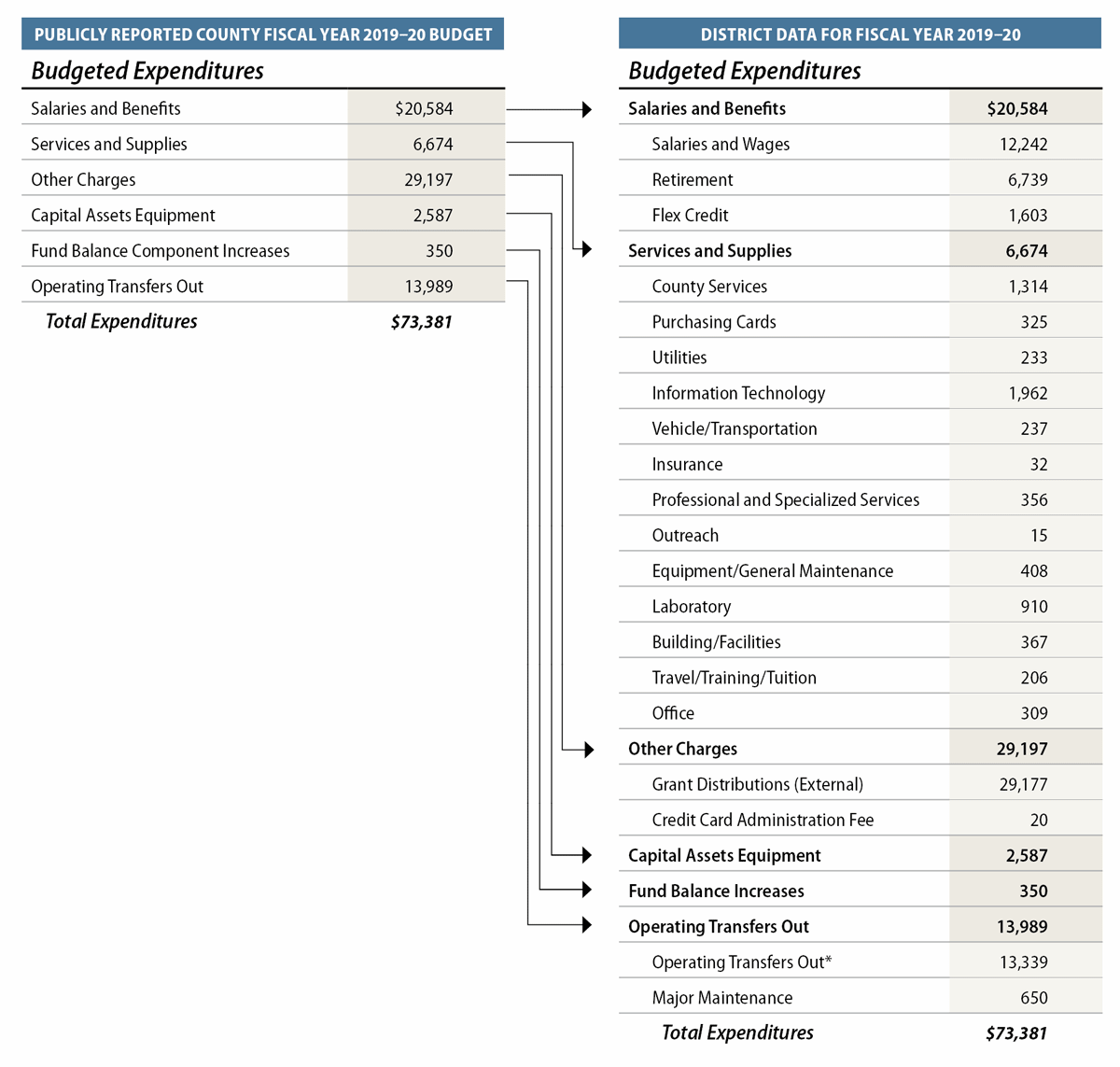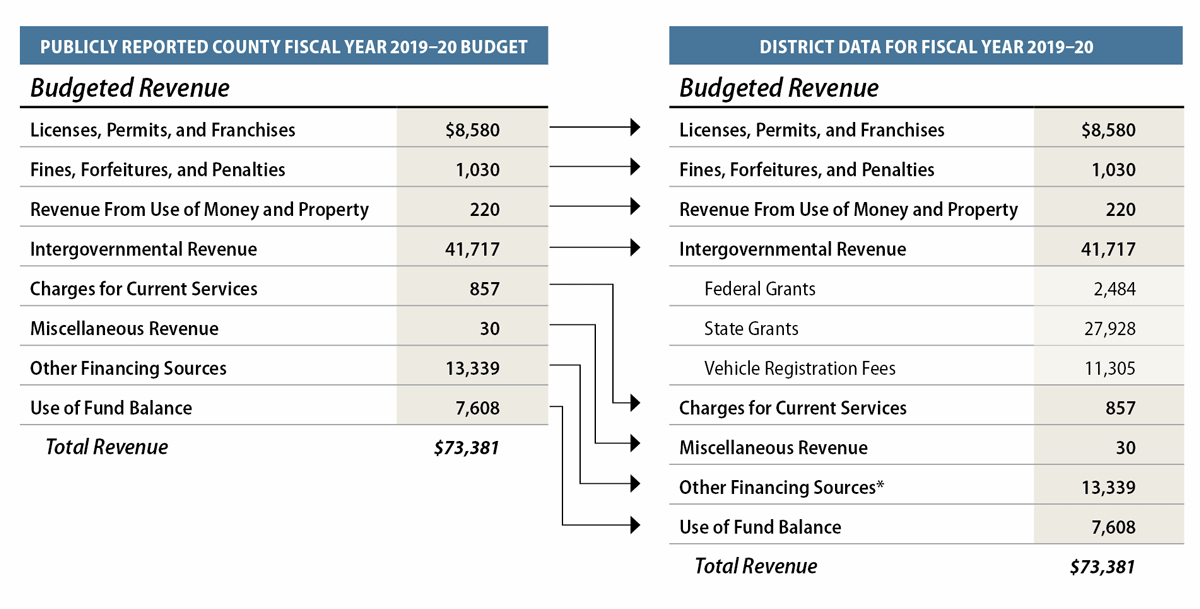Use the links below to skip to the appendix you wish to view:
- Appendix A—Scope and Methodology
- Appendix B—The San Diego Air District's Budgeted Expenditures and Revenue for Fiscal Year 2019–20
Appendix A
Scope and Methodology
The Audit Committee directed the California State Auditor to conduct an audit of the San Diego Air District's financial transparency and its interaction with stakeholders and the public regarding decisions that affect regional air quality. The audit scope included eight objectives. The table below lists the objectives that the Audit Committee approved and the methods we used to address them.
| AUDIT OBJECTIVE | METHOD | |
|---|---|---|
| 1 | Review and evaluate the laws, rules, and regulations significant to the audit objectives. | Reviewed relevant laws, regulations, and other background materials. |
| 2 | Review and evaluate the procedures and processes that the San Diego Air District used in making key environmental and public health decisions during the four most recent fiscal years. |
|
| 3 | Review the county's budget, financial statements, and other documentation for the past four fiscal years and determine the following:
|
|
| 4 | Review and evaluate a selection of timesheets and associated documentation for the San Diego Air District staff to determine the extent to which staff's time is being used for activities related to the district's responsibilities and mission. To the extent possible, determine whether staff provided support for activities in the land use and environment group outside of the scope of the responsibilities of the district. If staff provided such support, determine the funding source. |
|
| 5 | Review the county's budgeting process as it relates to the San Diego Air District to determine the following:
|
|
| 6 | Determine whether the San Diego Air District has applied for any grants in the previous four fiscal years. For those grants awarded, determine amounts the district has received and review a selection to determine compliance with key terms of the grants. |
|
| 7 | Review the San Diego Air District's and county's outreach efforts to solicit public input related to its management of air quality programs. Compare those efforts to those of a selection of other large air pollution districts in California, and also determine the following:
|
|
| 8 | Review and assess any other issues that are significant to the audit. |
|
Source: Audit Committee's audit request number 2019-127, planning documents, and information and documentation identified in the table column titled Method.
Assessment of Data Reliability
The U.S. Government Accountability Office, whose standards we are statutorily required to follow, requires us to assess the sufficiency and appropriateness of the computer‑processed information that we use to support our findings, conclusions, and recommendations. In performing this audit, we relied on the following data and systems:
Public Complaints
We relied on the San Diego Air District's Business Case Management System (case management system) to calculate various statistics related to the public complaints it received from fiscal years 2016–17 through 2018–19. To evaluate these data, we performed electronic testing of the key data elements. We assessed the accuracy of these data by randomly selecting claims from the case management system and tracing key data elements from each claim to supporting evidence maintained by the district, and we assessed the completeness of the data by determining whether there were gaps in the sequential numbering of the complaint records. We determined that these data were not sufficiently reliable for the purposes of supporting conclusions or recommendations, due to missing records and inaccuracies. Nonetheless, we present calculations from these data in the report because they are used primarily for contextual purposes and represent the best source available.
Financial Activity
We relied on data from the San Diego Air District's Performance Budgeting System to assess its revenue and expenditures for fiscal year 2018–19. We verified the accuracy of these data by randomly selecting revenue and expenditure categories from the data and tracing key data elements to supporting documentation, and we found no material errors. To verify completeness of the data, we compared it to the county's audited financial statements for fiscal year 2018–19 and determined that the data were materially complete. Consequently, we found the district's performance budgeting data to be sufficiently reliable for the purposes of analyzing the district's finances. We also used data from this system for fiscal years 2016–17, 2017–18, and 2019–20 for background or contextual information that does not materially affect findings, conclusions, or recommendations. Thus, we determined that a data reliability assessment of those data was not necessary.
Permits
We used data from the San Diego Air District's Business Case Management System, Permitting/Application System of Record to determine the number of permits issued or renewed by fiscal year. Because these data were purely informational and do not materially affect findings, conclusions, or recommendations, we determined that a data reliability assessment was not necessary.
Emissions
We used emissions data from CARB that the San Diego Air District incorporated in its state plan to show, for contextual purposes, the estimated historical and projected future amounts of ozone‑causing emissions in the district and the sources of those emissions. Because these data are the output of a modeling system, it was not feasible to evaluate their accuracy or completeness. Consequently, we found these data to be of undetermined reliability for the purposes of establishing the level of ozone-causing emissions in the district. Although this determination may affect the precision of the numbers we present, there is sufficient evidence in total to support our findings, conclusions, and recommendations.
Appendix B
The San Diego Air District's Budgeted Expenditures and Revenue for Fiscal Year 2019–20
Because it currently operates as a county department, the San Diego Air District participates in the county's annual budget process, and the county provides a high-level summary of the district's major expenditures and revenue in the operational plan presented on its website. However, this summary does not provide a clear description of the nature of those expenditures and revenue. Working with additional financial data supplied by the district, we identified more detailed expenditure and revenue categories within the general categories presented in the county budget for fiscal year 2019–20. To provide additional clarity, tables B.1 and B.2 present the district's published expenditures and revenue for fiscal year 2019–20 as well as more detailed information for key categories.
Table B.1
The San Diego Air District's Publicly Reported Budget for Fiscal Year 2019–20 Expenditures Compared to a More Detailed Presentation of Its Budget Information (In Thousands)

Source: San Diego County Operational Plan for Fiscal Years 2018–19 and 2019–20 and San Diego Air District financial data.
* Operating Transfers Out consists of transfers between divisions within the San Diego Air District.
Table B.2
The San Diego County Air District's Publicly Reported Budget for Fiscal Year 2019–20 Revenue Compared to a More Detailed Presentation of Its Budget Information (In Thousands)

Source: San Diego County Operational Plan for Fiscal Years 2018–19 and 2019–20 and San Diego Air District financial data.
Note: The district categorizes permit fee revenue differently than the county does. For purposes of the table above, we use the county's method of categorization, which differs from the approach we used in our analyses of permit fees for fiscal year 2018–19 presented elsewhere in the report.
* Other Financing Sources consists of transfers between divisions within the San Diego Air District.